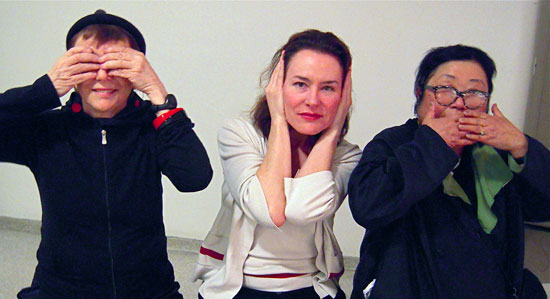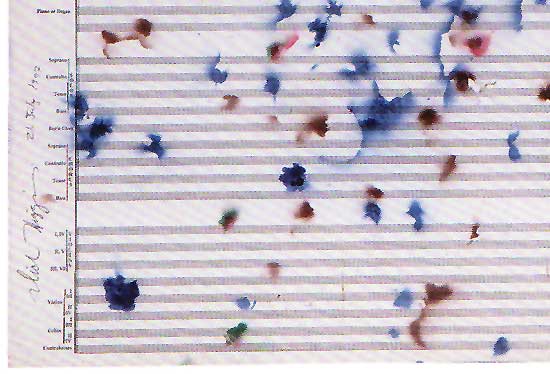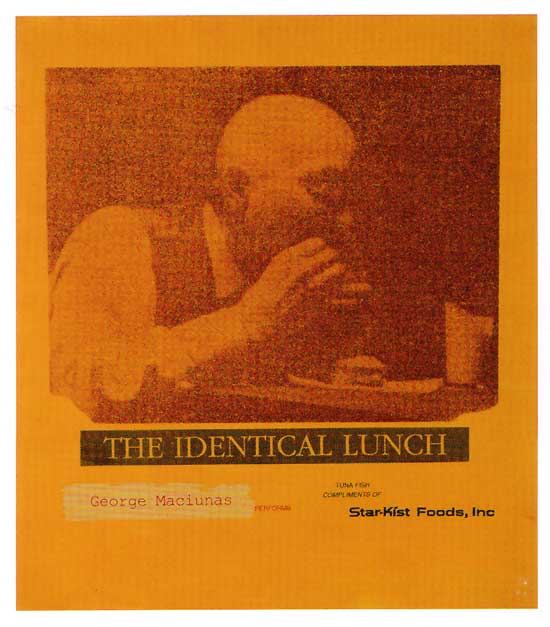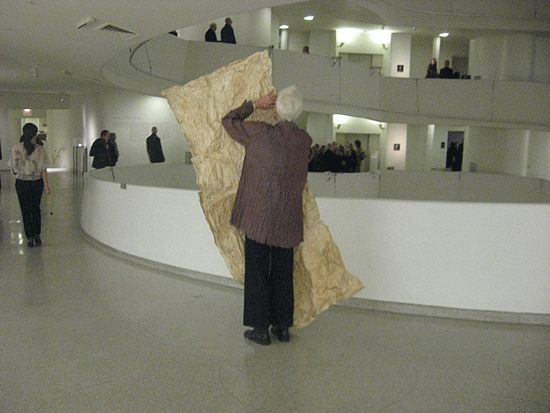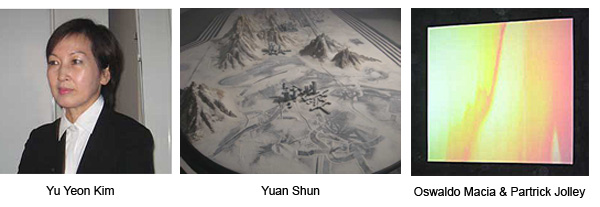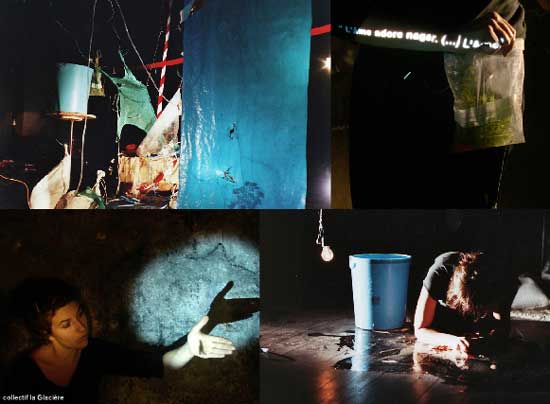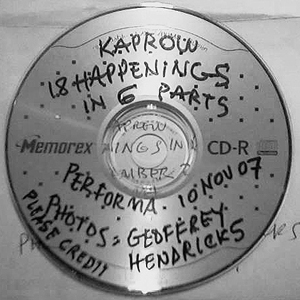The Third Mind: American Artists Contemplate Asia,
1860-1989 at the Guggenheim. Performance by Mary Beth Edelson, Jessica Higgins and Shigeko Kubota at the
Guggenheim preview reception for The Third Mind: American Artists Contemplate Asia,
1860- 1989, (AKA the Buddha show)
By intermedia artist Jessica Higgins
I was invited by Alison Knowles, to the formal dinner on January 28th and cocktails on the 29th. Of course I was thrilled to go, not only because the topic was of personal interest to me and to my own conceptual language, but I also felt honored to see so many of the faces I’d grown up seeing and relating to together or close by in the Guggenheim. The curator had a cozy alcove set aside for The Fluxus group of which I so fondly grew up experiencing around me in a childhood wildness to which I often refer now. The scope of the show is vast and brilliant, so for the purpose of expressing my views experientially I will contain them within that room and a few steps upward toward Larry Miller’s work. Dick Higgins, A Thousand Symphonies, Performance relic of Danger Music #12,
Symphony #860 1967/97 in Three movements.
In turning the corner, Dick Higgins, A Thousand Symphonies, Performance relic of Danger Music #12, Symphony #860 1967/97 in Three movements. The bullet holes reflecting a thought of war or questions on its opposite, such a random period in my life in Vermont. A period of harsh screams, pianos and typewriters somehow abstracted into something else, my father always seemed bigger or slightly abstracted by life itself.
Alison Knowles, The Identical Lunch [2nd Edition], 1973/93 silk-screens in cadmium
Close by Alison Knowles, The Identical Lunch [2nd Edition], 1973/93 silk-screens in cadmium yellow with her friends eating the tuna fish on whole wheat toast with buttermilk brought me back to such a different time. One when artists helped each other and a creative community bloomed. I find myself contemplating Joshua Selman’s amazing grip on culture in the 21st century and his extensive work on ArtistOrganzedArt.org. I flip back in time to the crazy reflections of parties with genital cakes, jelly’s and gender switched wedding’s occurring mostly in big open spaces. All those beautiful faces with concepts behind each one ready to share freely and laugh. Shigeko’s silkscreen reminded me of a full moon. Later I met her sitting like a Buddha and she was smiling, which I hadn’t seen in a while. I was introduced to Mary Beth Edelson, and in a spontaneous way we all made an event. “The quirky, abstracted, pull it together” sense re-merged in a flashback. 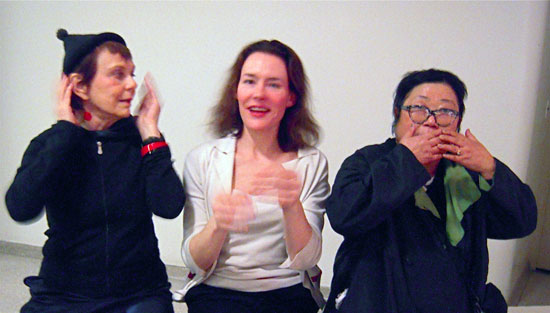
Performance by Mary Beth Edelson, Jessica Higgins and Shigeko Kubota at the Guggenheim preview reception for The Third Mind: American Artists Contemplate Asia,
1860- 1989, (AKA the Buddha show).Alison Knowles is handed Edelson’s
camera to record the spontaneous performative event.
Performance concept by Mary Beth Edelson, 2009.
In my brief wander upward Larry Miller’s piece about his mother strongly stood out as a relation to the Fluxus room, for me one of the most important later Fluxus artists to exchange and influence the next generation of artists who ponder the movement. He stood by his work talking as only he can about all that went into the work or the people who happened to be there, an event itself. The rambling wild thoughts became a trip about hypnosis, identity and Jack Kerouac who he happened to be reading when he made the piece. I walked back into the room and found myself drawn to the wonderful typography of Fluxus. The bold black lines and design that often draws me in and did as a child, all those boxes I associate with Maciunas and Brecht. I remember trying to sort through my own toys and being particularly fascinated by toys that came in boxes with pieces.
It was important for me to see George Brecht’s Water Yam, 1963 and Fluxus Internationale Festspiele Neuester Music. Several times during my childhood and very early adulthood I visited George Brecht. The few times I met him he had such charm with such fierce ideas. One intriguing visit took place in Koln at a large dinner with Alison Knowles, myself, her travel companion, Hermann Braun and several others who had joined us. At a large bistro specialized in types of beer, a large tub arrived at the table out of which emerged the enormous head of a roasted pig with hoofs and tail decorating the rim. The body was simply missing. The pig’s head was cooked and shiny, looking like it might open an eye. As the evening went by there were many rounds of Kilsch required to go with stories of friends and we talked about how it was for
me working with Alison at the WDR Radio station in Koln. The laughter, smoke and faces are still etched in my memory. Alison Knowles, my mother, invited me the following day on a trip to the Cathedral, it reminded me of a lighted sand castle as we climbed arduously to the top. Decades later on return I still associated Koln with Kilsch, lighted castles and WDR Horspiels and remember the climb standing in the Guggenheim.
Being at The Third Mind also brings me back to John Cage’s visits with my mother and the process of everyday life and everyday art. I saw so much of that in both of them. The outlines of life, the questions and experiences of life art, nature, food and the outlines of John’s smile … the thought of trying one of their mushrooms with concern as they looked them up in a big book … gentle giants … I wasn’t so sure I should try them, but they smelled good and the names were so beautiful … and John had co-founded the New York Mycological Society.
Alison Knowles, The Giant Bean Turner, 1995
Alison would later emerge from the swaying architecture carrying the beans in a way I can only begin to say how much I associate a large part of my early adolescence with constant thoughts about beans, whether in soup or in art the point was consistently pondered. She walked with her statuesque gait and appeared and disappeared being with the art she moved through her event. Somehow it had the extra-ordinary appeal of the ordinary with in it. She was just walking down the path.I could go on reminiscing about many of the others works in this show and the amazing culture and people I was lucky enough to meet that evening. But I will save that for another time and hope this vignette offers a view of experience reflected back into the eyes of a grown child of art who later became an artist herself.
Jessica Higgins
Meditation on Mediations— An East West Cultural Exchange: Dialogue, Misunderstanding, Growing Pains and an Evolution of Artists Before Egos

CamouFLASHED Mediations
Curators: Mariusz Soltysik, Aurelia Mandziuk, Anja Tabitha Rudolph, Roland Dolfing
Event in frame of Month of Mediations – MEDIATIONS Biennial, 3-30 of October 2008, Poznan, Poland
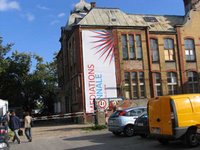 MEDIATIONS BIENNALE
MEDIATIONS BIENNALE
Biennale director: Tomasz Wendland
Voyage Sentimental, curator: Lorand Hegyl
Identity and Tolerance, curator: Gu Zhenqing
Corporeal/Technoreal, curator: Yu Yeon Kim
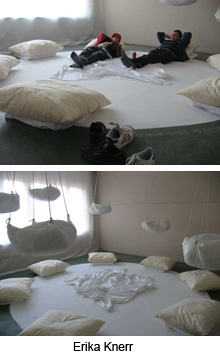
Thursday, October 2, 2008- As an artist in CamouFLASHED Mediations I had the luxury of actualizing my sound installation, Atmospirit, The Last Breath and the Big Wind on my birthday. The painted white circle on the floor was dry and I suspended the pillows from the ceiling. There were the typical problems of finding materials and tools. I needed a ladder to reach the ceiling and managed to negotiate one of the few available.There was some mix up that evening about when exhibitions were opening so Suzy Sureck and I went to the opening of “Voyage Sentimental” at the National Museum a day early and were turned away by the guards. Luckily, Eric Binder, a Slovakian artist from Bratislva, showing in “Voyage Sentimental,” was returning with supplies. He was able to get us past the guards as his guest. This was great to get a preview before the opening. Most of the work was installed and a few of the artists were hanging and/or finishing their installations. We were struck by the contrast of the slick white Museum space to our abandoned Old Printer house with all its character. I liked the less precious approach of Eric Binder finishing his large, playful, graffiti influenced drawings suspended directly from the ceiling. We also met Barthelemy Toguo from Cameroon with some of the strongest works in this show. There were quite a few big name art stars in this venue like Anselm Kiefer, Michelangelo Pistoletto, Hermann Nitsch, Arnulf Rainer, William Kentridge and Marina Abramovic among others. I was happily pleased to see the beautiful, straw blown drawings of Roland Flexner, from New York. I was also struck by the amount of figurative and narrative works here, but made sense for this more traditional setting.
 That evening at the Dragon Pub I spoke to artist Adam Klimczak about Dresden and the continuation of Camouflash there with the young group of artists who formed the UNACTO group about 2 years ago. Above all he stressed that there is something quite positive about the fact that the Dresden group of artists are trying to organized themselves, like we have done, in Lodz, and that’s a good thing. All the details are not so important in the end.
That evening at the Dragon Pub I spoke to artist Adam Klimczak about Dresden and the continuation of Camouflash there with the young group of artists who formed the UNACTO group about 2 years ago. Above all he stressed that there is something quite positive about the fact that the Dresden group of artists are trying to organized themselves, like we have done, in Lodz, and that’s a good thing. All the details are not so important in the end.“We focus on non-commercial, experimental and alternative work….created often in unconventional spaces such as streets, shops, factories or public places” Galeria Wschodnia, Lodz
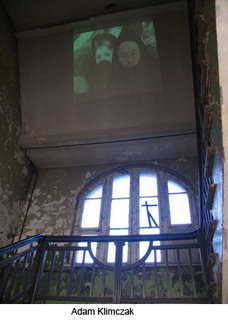 Friday, October 3, 2008. This was the longest day of the trip. I awoke early this morning at the Hotel Ryzimsky where most of the Mediations Artists were staying about a 15-20 minute walk to the Old Printer House, which housed CamouFLASHed Mediations and also one of the three feature exhibitions of Mediations Biennial, curated by YeoYeun Kim from New York, titled “Corporreal/Technoreal.” I got to the Printer House later than I had hoped. CamouFLASHed Mediations opened the next day at 12:30 PM. There was still an overwhelming amount of work to do to prepare for the opening. Reinigungsgesellschaft, an artist collaborative in the space next to me on the first floor had arrived to install their video, The Japanese Garden, 2008. We worked through a few problems with lighting and basic co-existense of
two installations with sound. There’s with the sound of children and a security guard explaining behavioral rules and the cultural meaning of the garden in Berlin at the recreation park “Gardens of the World,” mine with the sound of basic meditation instruction, overlaying the sound of wind and the breath of my father, a few days before he passed away.
Friday, October 3, 2008. This was the longest day of the trip. I awoke early this morning at the Hotel Ryzimsky where most of the Mediations Artists were staying about a 15-20 minute walk to the Old Printer House, which housed CamouFLASHed Mediations and also one of the three feature exhibitions of Mediations Biennial, curated by YeoYeun Kim from New York, titled “Corporreal/Technoreal.” I got to the Printer House later than I had hoped. CamouFLASHed Mediations opened the next day at 12:30 PM. There was still an overwhelming amount of work to do to prepare for the opening. Reinigungsgesellschaft, an artist collaborative in the space next to me on the first floor had arrived to install their video, The Japanese Garden, 2008. We worked through a few problems with lighting and basic co-existense of
two installations with sound. There’s with the sound of children and a security guard explaining behavioral rules and the cultural meaning of the garden in Berlin at the recreation park “Gardens of the World,” mine with the sound of basic meditation instruction, overlaying the sound of wind and the breath of my father, a few days before he passed away.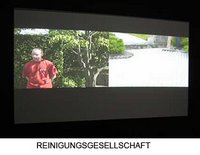 I was able to mostly finish my installation today and resolve some issues with the pillow heights and with the recommendation of a Viennese artist we met the day before, Clemens Fuertler, I wrapped the bases beneath the pillows with white cotton fabric. I was still unhappy about using a laptop for sound of the audio. It was not loud enough and the fact that the laptop with sound was stolen from my installation at “Disappearing in Art”, in Dresden, and was left without audio for 7 days of the installation was disconcerting. After many requests for speakers I ended the day with confidence that speakers would arrive by morning.
I was able to mostly finish my installation today and resolve some issues with the pillow heights and with the recommendation of a Viennese artist we met the day before, Clemens Fuertler, I wrapped the bases beneath the pillows with white cotton fabric. I was still unhappy about using a laptop for sound of the audio. It was not loud enough and the fact that the laptop with sound was stolen from my installation at “Disappearing in Art”, in Dresden, and was left without audio for 7 days of the installation was disconcerting. After many requests for speakers I ended the day with confidence that speakers would arrive by morning.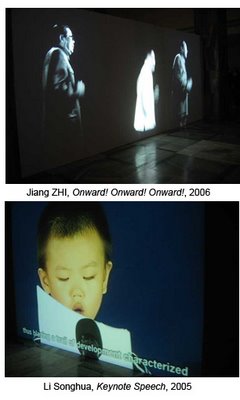
Friday night was the opening of the first two Mediatons shows, “Voyage Sentimental” at the National Museum and “Identity and Tolerance” at the Zamek Castle Cultural Center (Kultury Zamek). We missed the 6:00 pm opening at the National Museum still working on “Camouflash”. Luckily we saw the preview the night before with Eric. The contrast was dramatic between spaces. Ours is a gutted old unheated shell of the old Printer House (except my room actually has heat which I was given as a good space to encourage meditation). The National Museum space is a huge open atrium with many smaller, white boxed rooms. We did make it to the Zamek Castle. This was a Historic space. A favorite piece, a performance on the front steps, near the entrance, was a fallen angel by SunYuan & Peng Yu simply titled Angel, 2007. There were great videos in the lobby space of the Zamek Castle now the Cultural Center of Poznan.
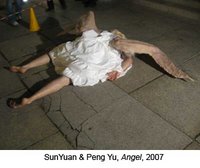 Upstairs was a large hall with people waiting for speeches from the curators and organizers. The entrance of the rest of the exhibition was down another hall near the beer tap and wine table. In trying to go in I was promptly stopped and pointed back toward the direction of the speeches, so more waiting, than another attempt to pass the ladies guarding the hallway to the artwork. Once again turned away by the stern, cross-armed guards. The speeches finally came and went with movement toward the drinking hall. We ran in to Warren, a Polish writer we knew from NY and had a brilliant talk about 12 years of living cycles. Warren was a fixture at every art event in NY for 12 years and has now migrated to Warsaw as he sees more happening here than in New York.
Upstairs was a large hall with people waiting for speeches from the curators and organizers. The entrance of the rest of the exhibition was down another hall near the beer tap and wine table. In trying to go in I was promptly stopped and pointed back toward the direction of the speeches, so more waiting, than another attempt to pass the ladies guarding the hallway to the artwork. Once again turned away by the stern, cross-armed guards. The speeches finally came and went with movement toward the drinking hall. We ran in to Warren, a Polish writer we knew from NY and had a brilliant talk about 12 years of living cycles. Warren was a fixture at every art event in NY for 12 years and has now migrated to Warsaw as he sees more happening here than in New York.
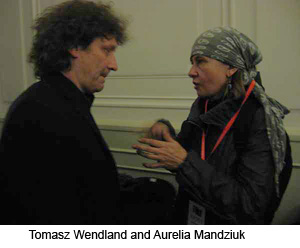 Next we were moved to a banquet where all the artists, organizers and curators where invited for a big spread of sushi, polish dishes, fruits and drinks. Off the balcony, there was a lovely view of the Castle gardens. Being that our opening was the next day at 12:30 pm, Mariusz, Agata, Aurelia, Margaret, Henrich from the Dresden group and other artists & installers worked all night with one or two hours sleep to prepare works.CamouFLASHed Mediations was an enormous undertaking for the curators. It was overly ambitious and chaotic to deal with this beautiful old building, the Old Printer House in Poznan, smack next to a Sheraton Hotel and a short walk from the main railway Station (Poznań Główny). Not only did art need to be installed on three floors of about 8,000 sq. ft. each, walls were built and painted, electricity run to spaces for a huge number of monitors, projectors, lights, speakers, laptops etc. to be set up and all of this in only 4 days before the opening. This is an amazing “portrait” of overcoming obstacles.
Next we were moved to a banquet where all the artists, organizers and curators where invited for a big spread of sushi, polish dishes, fruits and drinks. Off the balcony, there was a lovely view of the Castle gardens. Being that our opening was the next day at 12:30 pm, Mariusz, Agata, Aurelia, Margaret, Henrich from the Dresden group and other artists & installers worked all night with one or two hours sleep to prepare works.CamouFLASHed Mediations was an enormous undertaking for the curators. It was overly ambitious and chaotic to deal with this beautiful old building, the Old Printer House in Poznan, smack next to a Sheraton Hotel and a short walk from the main railway Station (Poznań Główny). Not only did art need to be installed on three floors of about 8,000 sq. ft. each, walls were built and painted, electricity run to spaces for a huge number of monitors, projectors, lights, speakers, laptops etc. to be set up and all of this in only 4 days before the opening. This is an amazing “portrait” of overcoming obstacles.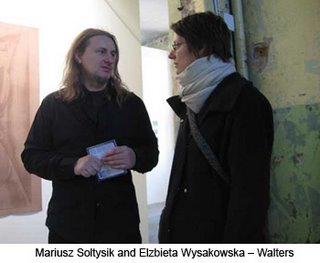 “Camouflash” was first shown in a smaller venue, an old office building connected with the Patio Art Center, in Lodz, Poland, in October 2007. Conceived by Mariusz Soltysik and co-curated with Aurelia Mandziuk, this show was tight and concise in its curatorial vision and openness toward supporting it’s artists to realize their works. At the time there were also obstacles to leap in terms of the building, wiring and cleaning an old building for a show that was almost all media based. This idea in itself is a paradox; to show so much new media in an old world building that was not at first technology friendly.So this was a similar case in Poznan, but on a much bigger scale. The next obstacle was moving from its second incarnation, “The Disappearing in Art” that took place in Dresden in a contemporary building shell of future offices, a little more than a month earlier. A group of young artists from a group called UNOACTU in Dresden, headed up by Anja Tabitha Rudolph became interested in “Camouflash” after their first UNOACTU project in which Mariusz Soltisik, Adam Klimczak and others from Lodz were involved.Soltysiks approach was adopted by UNOACTU. At this point, a mixed encumbrance occurred. UNOACTU took Soltysiks concepts and ideas in “Camouflash” and augmented them thematically, with the subtitle “Disappearing in Art,” expanding the ideas of hyper-reality and presenting “Camouflash” no
w in Dresden. Interestingly an experiential and generational shift occurred, where a group of young, recently graduated art organizers are hosting a group of seasoned artists and organizers with a long and important history from Lodz.
“Camouflash” was first shown in a smaller venue, an old office building connected with the Patio Art Center, in Lodz, Poland, in October 2007. Conceived by Mariusz Soltysik and co-curated with Aurelia Mandziuk, this show was tight and concise in its curatorial vision and openness toward supporting it’s artists to realize their works. At the time there were also obstacles to leap in terms of the building, wiring and cleaning an old building for a show that was almost all media based. This idea in itself is a paradox; to show so much new media in an old world building that was not at first technology friendly.So this was a similar case in Poznan, but on a much bigger scale. The next obstacle was moving from its second incarnation, “The Disappearing in Art” that took place in Dresden in a contemporary building shell of future offices, a little more than a month earlier. A group of young artists from a group called UNOACTU in Dresden, headed up by Anja Tabitha Rudolph became interested in “Camouflash” after their first UNOACTU project in which Mariusz Soltisik, Adam Klimczak and others from Lodz were involved.Soltysiks approach was adopted by UNOACTU. At this point, a mixed encumbrance occurred. UNOACTU took Soltysiks concepts and ideas in “Camouflash” and augmented them thematically, with the subtitle “Disappearing in Art,” expanding the ideas of hyper-reality and presenting “Camouflash” no
w in Dresden. Interestingly an experiential and generational shift occurred, where a group of young, recently graduated art organizers are hosting a group of seasoned artists and organizers with a long and important history from Lodz.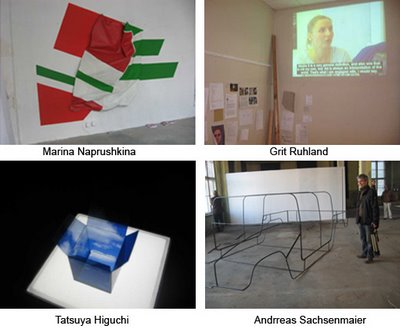 Looking at the experiential differences in cultural and generational shifts is one way of understanding the different styles of organizing. This was not only a cultural exchange between artists from Poland and Germany, but also between the parallel histories of both Dresden, from GDR, and Poland, coming from the soviet bloc era ending in 1989. A new generation of artists organizing in their twenties, grew up for the most part in a Germany undivided, giving them a different perspective. Egos are a huge part of the art world, commercial or otherwise and of the “artist” mentality. “Camouflash,” coming from a long history of Construction in Process, The International Artist Museum and Galeria Wschodnia is the anti market, anti economy driven art world, supporting social change through artistic exchange. It takes a position of artists for artists, where egos play a secondary role. This is antithetical to the commercial gallery system of the art world. This contrast of approaches is important to the continued shift of a post-communist Central Europe and for future generations of global artist organizers in general.
Looking at the experiential differences in cultural and generational shifts is one way of understanding the different styles of organizing. This was not only a cultural exchange between artists from Poland and Germany, but also between the parallel histories of both Dresden, from GDR, and Poland, coming from the soviet bloc era ending in 1989. A new generation of artists organizing in their twenties, grew up for the most part in a Germany undivided, giving them a different perspective. Egos are a huge part of the art world, commercial or otherwise and of the “artist” mentality. “Camouflash,” coming from a long history of Construction in Process, The International Artist Museum and Galeria Wschodnia is the anti market, anti economy driven art world, supporting social change through artistic exchange. It takes a position of artists for artists, where egos play a secondary role. This is antithetical to the commercial gallery system of the art world. This contrast of approaches is important to the continued shift of a post-communist Central Europe and for future generations of global artist organizers in general.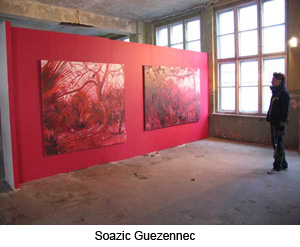
A third time around, this incarnation, CamouFLASHed Mediations was back in Poland for Poznan’s first international Biennial,with yet another expansion, including curator Roland Dolfing from Luxenboug, and Inner Spaces bringing in painter Soazic Guezennec, and others. CamouFLASHed is about something other than a tightly thematic Biennial exhibition and highlights it’s strong contrast to the three main shows supported by the Mediations Biennial. Tomasz Wendland brilliantly invited “Camouflash” as a large “fringe” exhibition to show a deeply multilayered, multi-cultural, inaugural Biennial presentation for Poznan.So with unquestionable odds and little funding all involved came together with big ambition in an enormous undertaking. There was chaos, many problems much compromising, swirling egos, envy of the finished white cube for some, incredible dedication, fear, frustrations, family, dancing, laughter and drinking, very little sleep, a nice hotel, over 300 artists from around the world all convening on Poznan for the Mediations Biennial because of the efforts of Thomas Wendland & Co.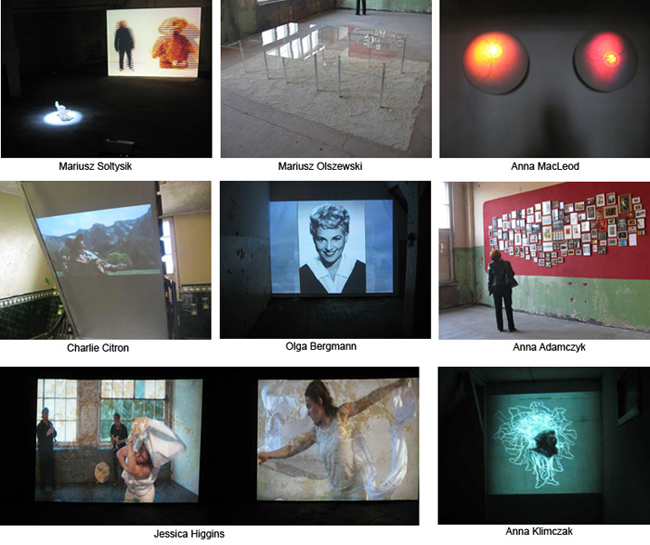 Saturday October 4, 2008
Saturday October 4, 2008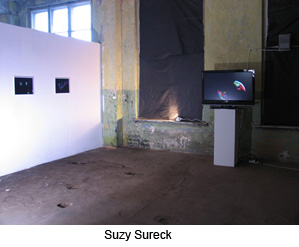 Saturday morning Suzy and I had to check out of our hotel, drop bags at the Train station and get to the Exposition before the opening at 12:30 pm. I needed to check on the sound of Atmospirit. On arrival I found boxes of brand new Creative speakers and a DVD player and 2 laptops. More than I needed. I had a very short time to set it up myself, since everyone else was still installing, cleaning on the second and third floors and perhaps rooms down the hall from me, on the first floor. A little miracle happened and I hooked it up right the first try and the sound was perfect for the room.
Saturday morning Suzy and I had to check out of our hotel, drop bags at the Train station and get to the Exposition before the opening at 12:30 pm. I needed to check on the sound of Atmospirit. On arrival I found boxes of brand new Creative speakers and a DVD player and 2 laptops. More than I needed. I had a very short time to set it up myself, since everyone else was still installing, cleaning on the second and third floors and perhaps rooms down the hall from me, on the first floor. A little miracle happened and I hooked it up right the first try and the sound was perfect for the room.
Breaking through our limited expectation
of the way things should be, and when
things happen spontaneously, in unexpected
ways, we learn from this.
Yu Yeon Kim’s opening of “Corporeal/Technoreal” took place in the same Printer House building as CamouFLASHed and opening at 12:00 noon, just a half hour before ours. “Corporeal-Technoreal” is part of the main program and had a different quality. It was a strongly curated new media exhibition of video work and one sculptural floor installation by Yuan Shun. His “O” Project, of a mist shrouded landscape of the Forbidden City was a stand out. The content of Yu Yeon Kim’s show was the harshest, most heavily psychological. Another favorite was Oswaldo Macia & Partrick Jolley’s, Soufle, 2008, film, sound. The room on first glance showed projections that looked like beautiful color field painting. On further investigation one realizes the color comes from “flowing surfaces of edible sauces and the audio track is of machines used in slaughterhouses. The sauce also feels like blood.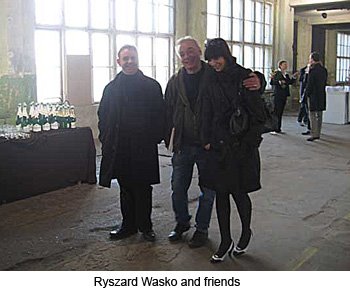 A highlight of the day was seeing Richard Wasko there. I was very happy to see him after many years and he is in good form. He was there with Marika Kuzmicz and friend, from Rempex, Galeria Sztuki Wspólczesnej in Warsaw. He joked that this photo would appear in the New York Times, only better here for AOA. The enigmatic Wasko disappeared as quick as his wit. He has a big exhibition up now at the National Museum in Lodz documenting his years there and in Berlin.
A highlight of the day was seeing Richard Wasko there. I was very happy to see him after many years and he is in good form. He was there with Marika Kuzmicz and friend, from Rempex, Galeria Sztuki Wspólczesnej in Warsaw. He joked that this photo would appear in the New York Times, only better here for AOA. The enigmatic Wasko disappeared as quick as his wit. He has a big exhibition up now at the National Museum in Lodz documenting his years there and in Berlin.
Now there w
as movement upstairs for more speeches by the curators of CamouFLASHed this time. After this was a strong performance by Janusz Baldyga titled, Cheated – Rescued, 2008. At the beginning of the performance he announces, “Be Careful With Glass”. There were two pieces of glass, one wrapped with bandage with an image of a soaring hawk , the other plain, laying flat on the floor. He slowly unwrapped the glass, while at the same time wrapping himself in the bandage, letting it fall time after time and finally shattering on the floor. The second part consisted of taking the plain glass sheet, sliding it down a corner of the wall till it fixed itself there. It eventually smashed from the force of gravity some time after the performance ended.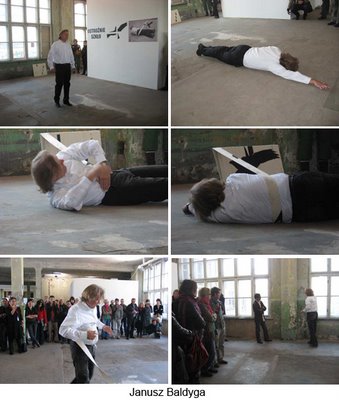
The other performance by Gabriele Horndasch called Found Footage, 2008, became a wall installation on it’s completion. She started the dart throwing earlier that morning, before the opening and ended about a half hour into the opening. Each throw of the dart is replace with a nail where a wire hoop in hung. There is a beautiful sense of time in this work where the image on the wall is built up slowing creating a layered wall drawing. The active, almost violent action of throwing the large dart is offset by the stillness of the final piece.
Event in frame of Month of Mediations – MEDIATIONS Biennial, 3-30 of October 2008, Poznań
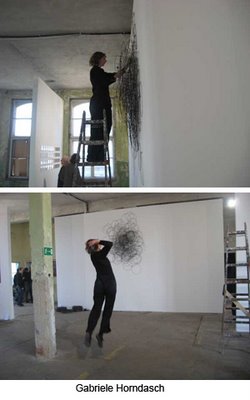
Artists:
Anna Adamczyk, Chrisitian Aschman, Janusz Bałdyga, Olga Bergmann, Martin Brazina, Sarah Browne & Gareth Kennedy, Henrik Busch, Agnieszka Chojnacka, Charlie Citron, Stephen Cornford, Disorientalism, Shige Fujishiro i, Sven Giessmann, Karolina Głusiec, Kristaps Gulbis, Shilpa Gupta, Soazic Guezennec, Tobias Hantmann, Eytan Heller, Jessica Higgins, Tatsuya Higuchi, Gabriele Horndasch, Eric Van Hove, Markus Huemer, Bernd Imminger, Adam Klimczak, Anna Klimczak, Erika Knerr, Patricia Lippert, Krzysztof Łukomski, Christine Mackey, Anna MacLeod, Cristina Maldonado, Tomasz Matuszak, Nadja Verena Marcin, Marina Naprushkina, Aisling O’Beirn, Łukasz Ogórek, Mariusz Olszewski, Arianne Olthaar, Pia MüllerSusana Pedrosa, Wiktor Polak, Ewa Szczyrek–Potocka, REINIGUNGSGESELLSCHAFT, Grit Ruhland, Andreas Sachsenmaier, Mariusz Sołtysik, Suzy Sureck, Aki Tarr, Richard Thomas, Elżbieta Wysakowska – Walters, Miyuki Yokomizo
CAMOUFLASH – DRESDEN
Curators:
Mariusz Sołtysik, Aurelia Mandziuk and Anja Tabitha Rudolph
Organizator: UNOACTU
co-organizar: PATIO Art Center, Academy of Humanites and Economics in Lodz.
http://www.unoactu.org/en_camouflash.html
http://patio.art.pl/wystawa.php?id=40
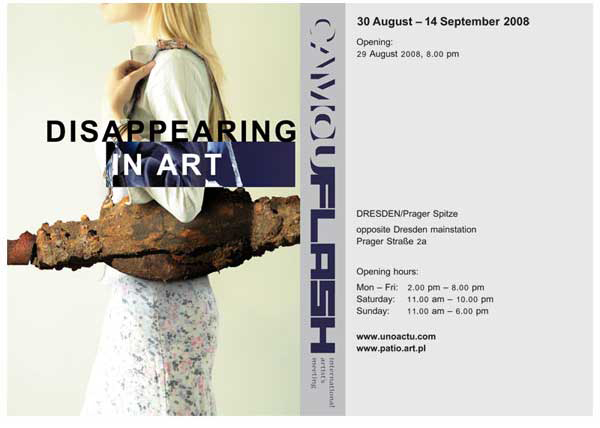
SHILPA GUPTA (India), KATHERINE BEHAR (USA), ALLAN HUGHES (Northern Ireland), REINIGUNGSGESELLSCHAFT (Dresden), JANUSZ BALDYGA (Poland), ERIC VAN HOVE (Belgium), HARRO SCHMIDT (Hanover), MARIUSZ OLSZEWSKI (Poland), ULU BRAUN (Berlin), MARKUS HUEMER (Berlin), AKI TARR (Dresden), DANIEL BIESOLD (Berlin), SUZY SUREK (USA), TAKAKO KIMURA (Japan), YOSHIAKI KAIHATSU (Japan), ERIKA KNERR (USA), DANIEL RODE (Dresden), ANDREAS SACHSENMAIER (Berlin), OLGA BERGMANN (Iceland), TATSUYA HIGUCHI (Japan), ARIANNE OLTHAAR (Netherlands), DIETER LUTSCH (Berlin), CHRISTINE MACKEY (Ireland), KRISTAPS GULBIS (Latvia), ANDRÉ MAROSE (Berlin), ANNA MACLEOD (Ireland), BERND IMMINGER (Berlin), JESSICA HIGGINS (USA), MARTIN BRAZINA (Czech Republic), EWA SZCZYREK-POTOCKA (Poland), GABRIELE HORNDASCH (Düsseldorf), MARIUSZ SOLTYSIK (Poland), MIYUKI YOKOMIZO (Japan), TOMASZ WENDLAND (Poland), BOSSE SUDENBURG (Berlin), TOMASZ MATUSZAK (Poland), ADAM KLIMCZAK (Poland), PIA MÜLLER (Düsseldorf), AISLING O´BEIRN (Northern Ireland), TOBIAS HANTMANN (Cologne), GRIT RUHLAND (Wuppertal), CHARLIE CITRON (USA), SARA PFROMMER (Dresden), NÁNDOR ANGSTENBERGER (Berlin)
CAMOUFLASH Cinema:
DISORIENTALISM (USA), DONG JOO LEE (South Korea), LUKASZ OGOREK (Poland),
KRZYSZTOF LUKOMSKI (Poland), SARAH BROWNE & GARETH KENNEDY (Ireland), AGNIESZKA CHOJNACKA (Poland), MARINA NAPRUSHKINA (Belarus), HENRIK BUSCH (Dresden), RICHARD THOMAS (Australia), WIKTOR POLAK (Poland), SUSANA PEDROSA (Portugal), CARLOS ALBERTO CARRILHO (Portugal)
Concept/Realisation Entry:
NEULANT VAN EXEL (Berlin)
The group UNOACTU based in Dresden, Germany, in cooperation with the Patio Art Centre Lodz, Poland is presenting the exhibition CAMOUFLASH – DISAPPEARING IN ART to open this friday 29 August, 2008. CAMOUFLASH began as an international artist’s meeting that was led by polish artist and curator Marius Soltysik, in Lodz, that I covered in October 2007.
For Dresden Soltysik’s concepts were used and the original group from Lodz is all exhibiting here. UNOACTU has broadened the theme that Mariusz began, based on concepts of Baudrillard’s theories. They have compared the ideas of other philosophers working in this arena, as well as consciously picked a location right next to the shopping mall across from the central train station in Dresden, which instantly underscores the theme. This project has created an intensive exchange between German and Polish artists.
More than 50 works of contemporary art will be exhibited in the building “Prager Spitze,” by artists from Japan, the USA, Australia, India and several European countries.
Many of the artists are arriving now to set up their installations and prepare for the opening. Another artist from New York, Katherine Behar, will begin a performance starting at the former Zentrum Warenhaus down the Prager Straße to the Prager Spitze, an hour before the official opening at 8 pm. Other talks, performances and a concert will follow.
MEDIATIONS Biennale in Poznan (www.mediations.pl) will present a selection of the artworks – about half of the exhibition – in October 2008.
Camouflash
The Disappearing in Art
Camouflash generates significant meaning through the combination of the words “camouflage” and “flash” which describes a paradox or convergence of opposites. “Camouflage” means both camouflage and hidden nature, and, “flash,” means a spark – an outstanding moment or message that is visible only for a short moment. This is an allusion to the schizophrenia of modern human beings in the society of media communication and public performance. Their endeavour culminates in competing moments, those of hiding and those enabling them to stand out in the crowd for a short moment – to gain identity for an instant. This topic is presented to the public directly in one of those places – where this schizophrenia is celebrated in a pre-eminent manner – within a shopping centre across from the main station in Dresden.
The subtitle “Disappearing in Art” departs from Baudrillard’s conceptual background. The entrance of the worlds of simulation and a matrix, sounded merely apocalyptic in the philosophy of the 80’s. The disappearing in the arts gives evidence to a process that existed in the past. If it is possible to pause, then options could appear that are yet unknown and altogether different than the proclaimed tendencies leading to an abrupt ending. The double meaning of the subtitle leads us to contradicting possibilities of interpretation. There opens space for associations creating significance. The merging of the dimensions of reality and arts into each other and the entailed reduction of their operation fields and efficiency might be interpreted, as well as simply dealing with this topi
c in the arts. Whereby the second in particular, enables a sober reflection of the process itself.
MS & ATR
Théâtre de la Cité Internationale, Paris, FranceScenes Ouvertes à L’Insolite
covered by artist Angie Eng
Théâtre de la MarionnetteThéâtre de la Cité Internationale, Paris, France
15-25 May 2008http://www.theatredelamarionnette.com/scenesouvertes.html
In a country rich with history, how does one approach innovation? Experimental Tradition seems to be all too common in the Art Festival de Paris. For three weeks in May, Le Théâtre de la Marionnette presented ‘Scènes Ouvertes à L’insolite’ (Open Stage For The Unusual) This umbrella program of cross-genre theatre included: theatre of manipulated objects, puppetry, video, shadow play, circus, spoken word, magic show, contemporary dance/movement, actors, tap dancers, improvisational music, poets, ‘clowns’, mimes, did I forget anyone, anything? From the description of sub-genres the public is immediately informed to not expect the Muppet show. The closest might be Daisy/Violet, the ½ human ½ puppet Siamese twin strippers of “Me Too, A Sideshow,” a performance ode to “Freaks” that merges the roles of object and manipulator.
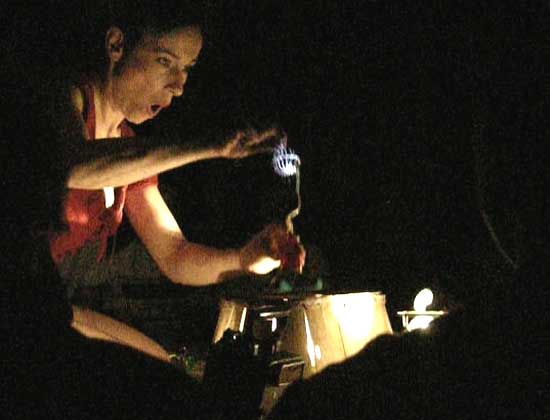
What we do realize after viewing a few performances, in my case 7 of the 14 presentations, is each collective remains faithful to the exploration of reality through the discovery of the make-believe. In other words, facing death by rebirth. As with a magic show, suspense is the key emotion to unravel the cycle of personal development. Like the art student exploring a canvas by copying the masters, the actor/manipulator reveals how the mind confronts existence. In “Desirée,” we are thrown into the cellar with a suffering abused girl who survives by recreating a dialogue between self, object and an imaginary persona. In coping with fear she displaces all emotion into gestural scenarios. Here is a production that presents ‘playing dolls’’ in a most dramatic, intense one-person drama, grâce à the performance of Coco Bernardis. And an honorable mention to the improvisational musician, Antoine Arlot who truly played visual sound.
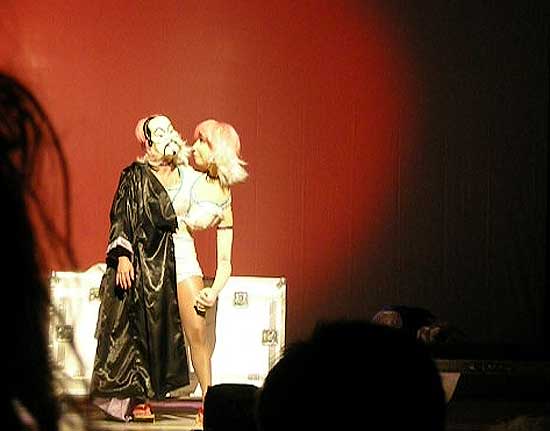
“Mr. H” (an adaptation of Dr. Jekyll and Mr. Hyde) is also a whirlwind in connecting the self with its multiple attempts and failures to illustrate life is a process. Visually dazzling as if watching a circus on acid, the three actors and one puppet move on, off, behind, sideways while playing tap dancing apes, reproducing via overhead projector “Journey to the Center of the Earth” mad scientist, syncing lights and alarms à la Richard Foreman, mocking Hollywood shadow dance and borrowing Film Noir in their mystic hysterics. Well, ‘I-can’t-remember-how-it-ended-but-I-liked-it-anyway’ was my reaction. It takes courage to cross the border.
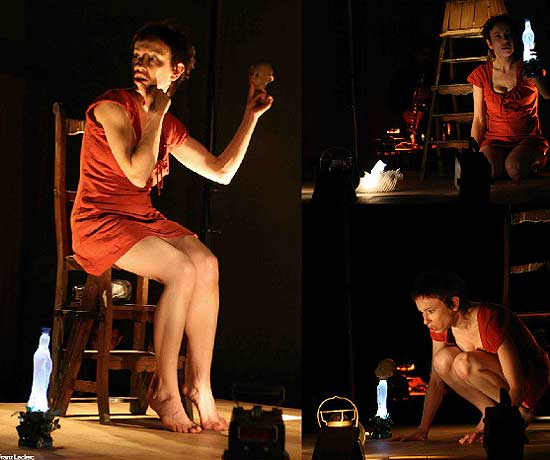
I’ve worked 15 years with experimental technology under the label of ‘New Technology’, ‘New Media’, ‘Interactive Performance’ and/or ‘Experimental Video’. 50% of the time the questions were geared toward equipment brands and software development in-progress. Questions of poetry and content were non-existent. In “Me Too: A Sideshow,” the story is about a baby puppet recounting his Siamese twin mother who reminisces of a time in a caravan by way of a video clip. (Did you catch that hall of mirrors?) Here, cinema is used as a dimension that could only be expressed by a window of moving images. (And nobody would ask how many lumens was the projector nor the name of the digital effects applied on the video!) Last month on the outskirts of Paris, I found myself every Sunday at the Théâtre de la Cité relearning the lesson on how marketing can jet your audience to a glacier mountain when the meeting point was in the Sahara. Under the heading of “Marionnettes” aesthetic parallels provided the base to the limitless use of tools and definition of ‘spectacle’.
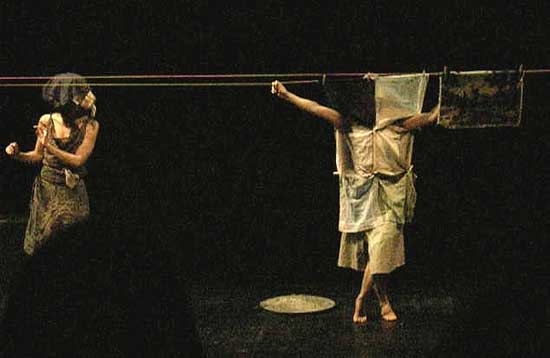
In Encore des Changements a poet crawls on the floor like a handicapped child reaching for a cord. Video projection is used to recite words projected on her arm as cinematic tree silhouettes dance inside the painter’s paint. At one point she fondles a huge mass of cotton like a Fluxus inspired media artist dancing with paper (Jessica Higgins in “North Water Song”). It’s so sensual you want this moment of simplicity that fulfills an urge to last longer. Spirituality and sensuality make a good couple. In the end as in the beginning and middle of the piece, a combination of techniques is used to examine the fragility of existence. The narrative arch seemed to be underdeveloped. Be that as it may, I still look forward to the next attempt.
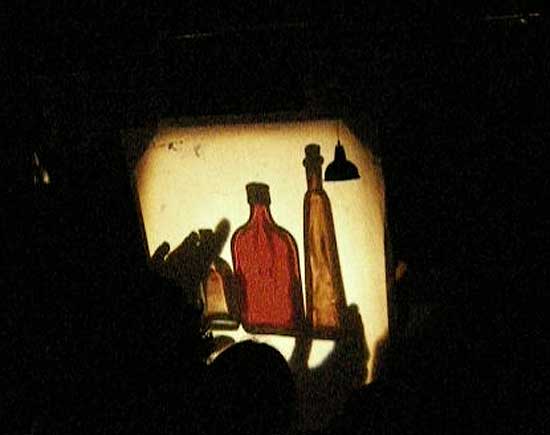
Incorporating cinema or merging forms effectively is no easy feat. However, the Festival Scènes Ouvertes à L’insolite’ gave me hope again. Breaking rules is necessary in experimentation, however there is a certain tradition that holds true- Start with a foundation and voyage to the ephemeral can bring fruitful results.

CAMOUFLASHan international artists meeting and exhibition.
October 2007, Lodz, Poland. Patio Art Center, The Academy of Humanities and Economics
http://www.patio.art.pl/_camouflash_eng.htm
Organized by Mariusz Soltysik and Aurelia Mandziuk
coordinators: Agata Nowicka, Małgorzata Nowak
Correspondent: artist Erika Knerr
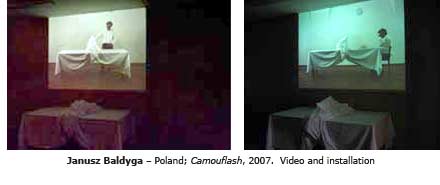 I have been intrigued by the city of Lodz, Poland for many years. In 1993, I was introduced to Construction in Process and the International Artist Museum in Lodz, while putting together an issue of New Observations Magazine that was guest edited by Suzy Sureck, about the CIP V event called “My Home is Your Home.” This was a very fertile time for The International Artists’ Museum, Lodz and this idea conceived by Ryszard Wasko in 1981, and formally established as the IAM, in 1990. I met Ryszard Wasko in New York in our tiny office in the Cable building at Broadway and Houston Streets. He was at once charismatic and generous in spirit. After going over the issue he said I should come to Sit-ations in Cardiff, Wales in 1994, and hence began my organic involvement with a remarkable group of artist organizers.
I have been intrigued by the city of Lodz, Poland for many years. In 1993, I was introduced to Construction in Process and the International Artist Museum in Lodz, while putting together an issue of New Observations Magazine that was guest edited by Suzy Sureck, about the CIP V event called “My Home is Your Home.” This was a very fertile time for The International Artists’ Museum, Lodz and this idea conceived by Ryszard Wasko in 1981, and formally established as the IAM, in 1990. I met Ryszard Wasko in New York in our tiny office in the Cable building at Broadway and Houston Streets. He was at once charismatic and generous in spirit. After going over the issue he said I should come to Sit-ations in Cardiff, Wales in 1994, and hence began my organic involvement with a remarkable group of artist organizers.
October, 2007 — Fourteen years and many projects later I have finally gone to Lodz. I was invited along with Suzy Sureck and Jessica Higgins from New York to participate in Camouflash, a media based exhibition curated by Mariusz Soltysik and Aurelia Mandziuk. Mariusz is an artist, long time member of The International Artist Museum and Construction in Process events and professor of media studies at the Fine Arts Department of The Academy of Humanities and Economics in Lodz. Aurelia is an artist and the Director of the Patio Art Gallery, housed at the Academy, who hosted the Camouflash, International Artist’s Meeting. Although the event lost some important funding and had to move it’s location to another raw building, across the courtyard from the gallery offices, because of flooding from severe rain some months before, it came together in the last moments in a wink of brilliance. Projections, video, installations, sculpture, photography and performance were exhibited in a three story building, where each artist had a room for their site specific projects.
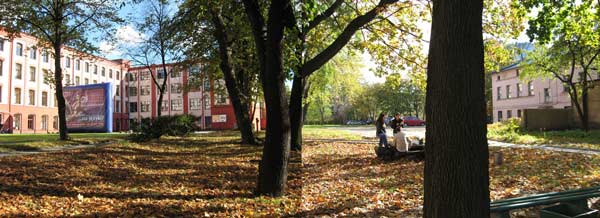
The beauty of the “International Artist’s Meeting” is this group of artists who have been working together for about 15 years doing site specific events all over the world. The large majority of the artists had worked together in various events before and it is interesting what is happening through time with the international and cultural exchanges between the artists. A continually evolving consciousness is shape shifting over time and feels important to this particular moment in history. The idea behind “camouflash” conceived by Mr. Soltysik boldly yet poetically grasps the critical dilemma of contemporary society.
Camouflash – is a free combination of the word camouflage, which means concealment, disguise, and the word flash which means a spark, moment, short message. The combination of these two words determines the subject of the exhibition, which is the condition of the contemporary man in the context of camouflaging oneself, and concurrently wishing to become known, to shine. This specific schizophrenia is by no means marginal, as proved, e.g. by the various reality shows, some of which attract artists, too.
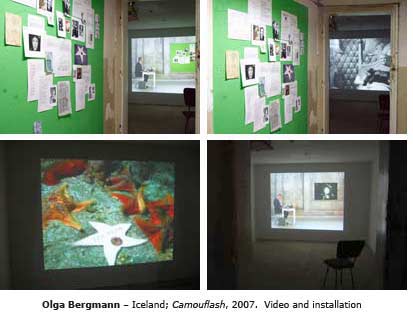 For me coming and going to Lodz was as much about absorbing the many histories there — personal, artistic and political, as it was in making my installation titled “Atmospirit,” for Camouflash. So to stay on task of covering Camouflash, we were picked up at the airport in Warsaw by a very gifted and interesting student Ella Wysakowska-Walters and her husband Jeremy along with artist Olga Bergmann
from Iceland. It is about a two and a half hour drive from Warsaw to Lodz. The next artist we met upon arrival at the WSHE in Lodz dormitories, where we lodged (about a half hour bus ride to the galleries) was artist Gabriele Horndasch who throughout the week was busily working on the streets of Lodz, casting five plaster moldings of different shaped bollards, or short posts outside of building entrances. She was the first artist to arrive almost a week before from Cologne, Germany. She was using Lodz artist Tomasz (Tomek) Matuszak’s bicycle which she diligently rode around the city, back and forth to our lodging and all the way to and from Manufactura’s large hardware supply store bringing many large bags of plaster to Tomek’s sculpture studio at another art school where he teaches sculpture in town. The studio was generously open for use by the Camouflash artists. Gabby had brought along a video projection already created at a residency in South Korea and decided to do a second project upon arrival. She ambitiously chose to work with a plaster casting technique for the first time, with the assistance of Tomek. Her working process throughout the week, buoyant spirit, the bicycle, and it’s fate, are embedded in my memory of the event.
For me coming and going to Lodz was as much about absorbing the many histories there — personal, artistic and political, as it was in making my installation titled “Atmospirit,” for Camouflash. So to stay on task of covering Camouflash, we were picked up at the airport in Warsaw by a very gifted and interesting student Ella Wysakowska-Walters and her husband Jeremy along with artist Olga Bergmann
from Iceland. It is about a two and a half hour drive from Warsaw to Lodz. The next artist we met upon arrival at the WSHE in Lodz dormitories, where we lodged (about a half hour bus ride to the galleries) was artist Gabriele Horndasch who throughout the week was busily working on the streets of Lodz, casting five plaster moldings of different shaped bollards, or short posts outside of building entrances. She was the first artist to arrive almost a week before from Cologne, Germany. She was using Lodz artist Tomasz (Tomek) Matuszak’s bicycle which she diligently rode around the city, back and forth to our lodging and all the way to and from Manufactura’s large hardware supply store bringing many large bags of plaster to Tomek’s sculpture studio at another art school where he teaches sculpture in town. The studio was generously open for use by the Camouflash artists. Gabby had brought along a video projection already created at a residency in South Korea and decided to do a second project upon arrival. She ambitiously chose to work with a plaster casting technique for the first time, with the assistance of Tomek. Her working process throughout the week, buoyant spirit, the bicycle, and it’s fate, are embedded in my memory of the event.
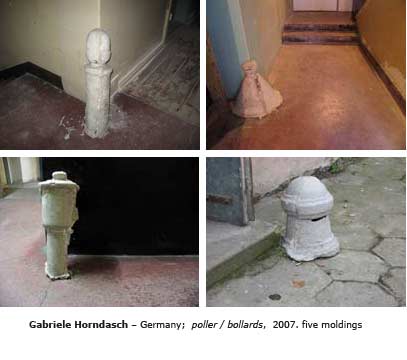
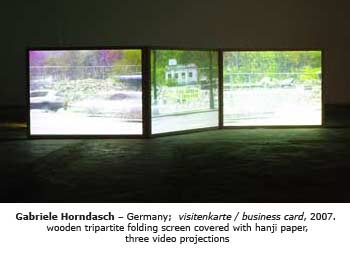
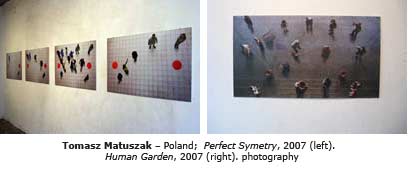
There was a lovely catered opening ceremony event at the The Museum of Cinematography for us, which is housed in the mid-nineteenth century palace residence of one of the most important Lodz industrialists from it’s past as a centre of the textile industry. The outside of the building is in contrast to the beautifully elegant, historically restored interiors. Lodz is a lively city of the arts with a long history of cinema and the world famous, Lodz film school. It’s been nominated as the Cultural Capital of Europe for 2016. I was told it is not as friendly to visual artists as it is to film and the attentions of Hollywood, and sorts like David Lynch who spends considerable time on projects there, collaborating with some of the artists I spent time with. Here at the museum we met Aurelia, who spoke to the group and all the artists were introduced.
Many of the participants had worked together during the past few years in the “Sense of Place” projects that took place throughout Europe and Iceland in 2005-06. A few artists were not in attendance. Aisling O’Beirn, worked on her project “Nicknames” from Ireland with Ella Wysakowska-Walters in Lodz who installed it at Camouflash.

Two other missing presences were Charlie Citron and Richard Thomas, both whom I was disappointed not to see again. Both have actively organized art events in their own countries. Charlie in the Netherlands and Richard in Australia. Charlie has organized numerous events, one that I participated in, in 2000, in Utrecht called “Misunderstanding.” It was of a similar spirit and scale to Camouflash with quite a few of the same artists. For Lodz he presented his GI Joe photo series “Joe Goes Around the World.” At the first floor entrance “Yosemite Joe” was projected with the sound track of an Otis Reading song. Upstairs on the third floor “Joe goes to India” played on a TV monitor. Citron has been working on the GI Joe photo series as long as I’ve known him. We met in 1995 at CIP Co-existence in Israel. He also guest edited a great issue of New Observation in 1999 call “A Memory Palace;” also an exhibition with the same name that year in Lodz. The “Joe” project becomes more interesting as the US role in the world is collapsing in on itself. Of it he says “I wanted to replay with my childhood puppet on the world stage. As a popular icon Joe personifies a reversal of himself by both revealing and camouflaging his identity within the cultural situations he participates in.”
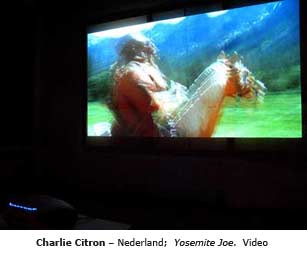
Richard Thomas hosted “The Bridge” Construction in Process VI, in Melbourne, AUS, in 1998. Richard showed the video “Severance” (20 mins). It was shot in 2004 in Tasmania, Australia during the burning season, when the loggers burn all the forest they have cleared during summer. “The video was made for an environment group ‘The Wilderness Society’ which is trying to stop the insane destruction of the largest remnant temperate rain forest in the world, the Tarkine Wilderness area… For me the experience was both stunningly beautiful and horrifying; it was a camouflash in that the harmonious integration of the complex natural ecology was periodically shattered by coming across shocking examples of destruction: human instigated ecocide,” says Richard Thomas.

Interventionist and provocateur, Belgian artist Eric Van Hove was introduced to the organizers by Richard Thomas. They had previously worked together at a project in China. Van Hove, who currently lives in Tokyo, Japan, gave a lecture on Tuesday afternoon at the Akademy of Humanities and Economics. He showed and spoke about a lot of projects made around the world. Eric works often with performative actions that are documented. The documentation becomes the work. One project was in Okinowa, Japan, an Island in the south pacific, where 60,000 GIs are placed. This project particularly caught my attention because my father (who passed away this year) was a medical doctor stationed there in WW II with the 6th Marine Division. 350,000 Okinawans fought and died to defend Japan in World War II.
Eric Van Hove’s project was installed in a vegetable market there. The old women had only cabbages and some vegetable and were burning them at the end of the day. They were widows, whose husbands had died at sea. The idea was to do a sustainable piece. A piece that they would be able to get some profit from in the long run. He built a crate, about the size of a coffin, in the market, near the place they burnt the vegetables at the end of the day. Eric imported 80,000 worms from Tokyo and placed them in the wooden box. The liquid from the worms was sold to the florists for fertilizer. The manure of earthworms is very good fertilizer and was sold to the farmers. 80,000 worms were $800.00 dollars, so they could also sell the worms, since they double population every month and a half. This was the ecological, sustainable and educational part of the project. Second faze. The constitution of Japan was written by the US. Okinawa was under US soil until 1980. There is much anger toward the constitution as the only ground fighting in WWII was in Okinawa. Also being fascinated by the gesture of burning books, he got photocopies of the Japanese constitution and fed it to the worms. He then recorded the sound of digestion of the worms munching the constitution with tiny microphones and broadcast it on the radio for the next week. It makes a sound similar to that of fire. All the women could sit around and listen to this on the radio. They did not have TV, but they had radio. It basically became a cathartic tool or stomach that digests problems. People were writing names of people and thoughts about war, and things that happened, and would feed it to the worms and listened to the sound on the radio with there friends while having a beer.
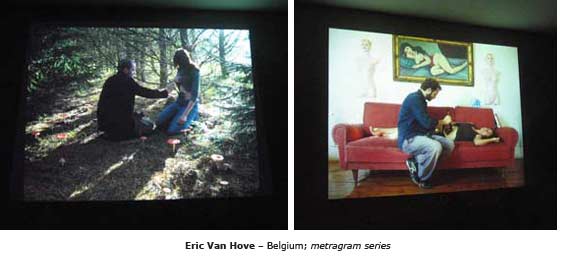
He ended the talk with works he calls “Abreactions.” An abreaction is a psychoanalytical term for reliving an experience in order to purge it of its emotional excesses; a type of catharsis. He uses automatic poetry that is written on the ground in a busy area of a town. He uses a language on purpose, that cannot be understood in the country he is working in. He will write one long, automatic writing line in the city, written with 200 pieces of chalk. Many adventures and public reactions occur during these events and they are usually documented in video. Done In Tehran, Shanghai, Dakar and many other cities, Van Hove releases an emotional abreaction of himself, but soon it becomes a public space. Most people think an act of writing in public will be a political statement, but in the end it is just poetry. Eric ended his lecture with a video filmed in Shanghai, by Richard Thomas. During the discussion period Lukasz Guzek, a professor at WSHE and editor-in-chief of spam.art.pl, who had brought his class, asked about Fluxus, and there was a dialogue about the influence of the ideas of Fluxus in Eric’s work. It was quite interesting to find out that Guzek uses Fluxus founding member, Dick Higgin’s famous intermedia chart in his classes and there is an emphasis on teaching “Intermedia,” coined by Higgin’s at the WSHE Akademy .
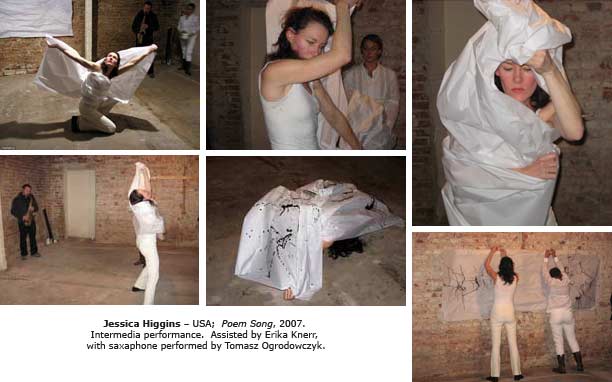
Jessica Higgins, daughter of Dick, performed a precise intermedia piece called “Poem Song,” at the opening of Camouflash. There was audio voice of Higgin’s reading haiku poems she had written for an earlier work called “Poet Walk,” 2002. She performed with saxophone player Tomasz Ogrodowczyk and myself, Erika Knerr, wrapping herself in and out of a large vellum scroll. Sounds of crinkling paper emerged. The saxophonist played to her movement and structure whenever she stopped. The first scroll was pinned the back wall. For the second scroll I made quick markings in black ink like musical notes to be interpreted by the musician. This intermedia work lives between poetry, music, dance and drawing. It was an enormous honor for me to perform with Jessica.
The same night we had a large group dinner at an Italian restaurant around the corner from Lodz Kaliska. This was our central meeting place, where you where sure to find the group after working hours at the gallery. Lodz Kaliska is a pub on the main Piotrkowska street, also named after the legendary neo-Dadaist artist collective formed in 1979, making films, actions, photographic stagings and exhibitions and are still active today. The interior is a tribute and museum full of the groups provocative photographs and documentation.
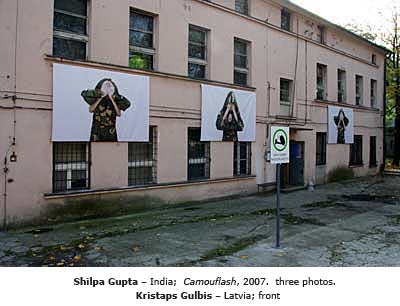
The other absent artist was Shilpa Gupta, from India who I would have loved to meet. Her honed and astute photographs were used to publicize the event on Patio’s website. Her images and video performances have been receiving critical acclaim internationally. The work of this young artist stands out for it’s clarity and razor sharp vision. The three photos shown here were of a young women dressed in camou gear and depicting the three monkey stories made popular in a speech by Gandhi. They stood for values propagated at the birth of a new nation “See No Evil,
Speak No Evil and Hear No Evil.” Shilpa’s large photographs where mounted outside the buildings facade. Also outside the entrance was the Latvian artist, Kristaps Gulbris‘ mounted signpost titled, “no security cameras here.” A clever nod to the reality of the big brother world we are living in.
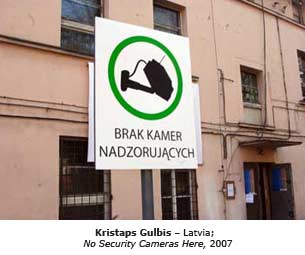
Because of the bare bones of the building designated for Camouflash, there was a lot going on to prepare the spaces; electricians working to ready the rooms for all the video equipment and lighting, painting and mopping etc. Most of the show came together at the last moments on Friday before the opening. A majority of the works were video and projections. The video works were quite stunning in the raw spaces. Suzy Sureck, from New York showed two video projections that were facing each other in another room created on the first floor. In “Groundless Earth, a Language of Roots” she was bringing her roots back to Poland, in a reversal of the original movement of her grandparents Eva and Edward Sureck who came to New York from Poland in 1904 and 1907. Both videos were made with dug up roots from her upstate NY home and the soft images were created using spot lights making the roots visible then disappearing through illumination. The work was dedicated to her mother who passed away last year. About it she says “Since my mothers death last year I have felt the groundlessness of her loss and felt the vastness of her spirit.”
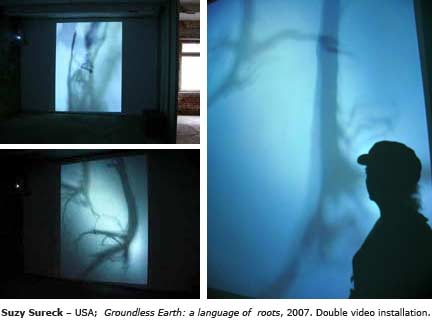
Suzy and I were in contact a great deal prior to coming to Lodz. As we were developing our pieces it was somewhat eerie, the similarities of our projects. It was of great comfort to me to have her attentions throughout this project. Without her support and enthusiasm I would not have been involved in Camouflash and I owe her a huge thanks. Suzy had been invited to participate a year or so ago and with her gentle prodding she suggested the possibility of Jessica Higgins and I also coming from New York. Lucky for us, Mariusz happily agreed and formal invitations arrived in our emails. Suzy and I both responded to Mariusz’s theme in a similar way, seeing right away it’s connections to Tibetan meditation practice, that we have both been studying together, and on our own for the last few years. We also both lost a parent not long ago and Suzy had been working with an idea for Camouflash about her mother’s passing. She changed direction a few times, before coming up with presenting pure video, as transporting the dug up roots internationally became problematic.
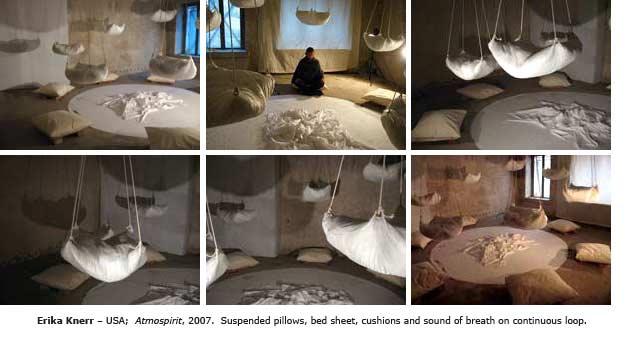
My interpretation of the Camouflash theme was an existential one based on the experience of witnessing my father’s last breathe. Titled “Atmospirit,” I used a soundtrack looped with 30 seconds of my dad’s breathing, a few days prior to his leaving his body, and 15 seconds of silence. I used seven suspended pillows in a circle, seven covered pillows on the floor underneath, that were meditation cushions, around a white painted circle on the floor of the square room on the first floor. Inside the circle was a white bed sheet. The moment of silence in the soundtrack is the spirit leaving the physical body and becoming camouflaged in the atmosphere, thus combining the two worlds/words atmosphere and spirit. It was a difficult, yet cathartic process for me to work through, so soon after my father’s death. I had intended the viewers to come in and sit on the cushions, to listen to the breathe, as one would follow their own breath as the object of meditation practice, but no one did. People responded to it as a sacred and untouchable space to walk around and not interact with, much as they would view any artwork. This makes me want to continue working with sound, to find ways to invite the audience to participation, activating the room as a public space for meditation, and thoughts coming and going.
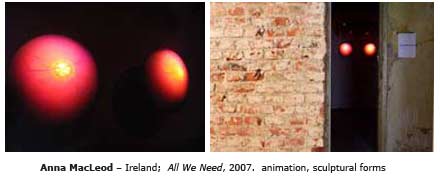
Anna Macleod, from Ireland, brought two projections for her installation “All We Need,” in a first floor room next to mine. She cast two circular discs in plaster, that were mounted to the back wall, then projected onto, with two aprox. one foot round, glowing red, organic circles. The scale and aura was quite powerful and strange. Anna is a lively conversationalist who filled us in on stories from the “Sense in Place” projects and The Leitrim Sculpture Centre in Manorhamilton, Northern Ireland where she works with Director Sean O Reilly. One late night Anna even sang us a beautiful Irish ballad at the Lodz Kaliska, after a day of rolling long blue strips of plastic for a second installation she created, on the third floor, called “Forecast” .
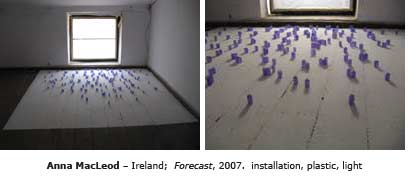
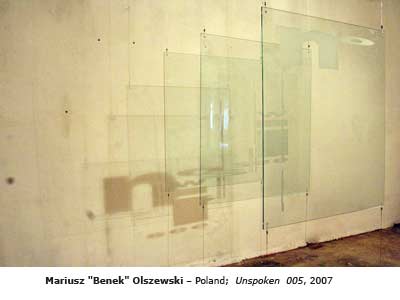
Mariousz “Benek” Olszewski, another important Lodz artist, collaborator, made a minimal suspended glass piece called “Unspoken 005.” He spent many days waiting for the arrival of the glass and had to construct the work quickly in the last 2 days. In the mean time he worked with Miyuki Yokomizo with her complex work that came together in stages. She had shipped the many small, battery operated lights from Japan and covered them with ping pong balls, to create a softer light. These were set up outside and photographed to create the “runway” image, then made into a projection, on the second floor of the exhibition. The lights were then re-set up to re-create the runway in front of the projection where it continued out into real space. Miyuki also did a second installation on the third floor using butterfies.
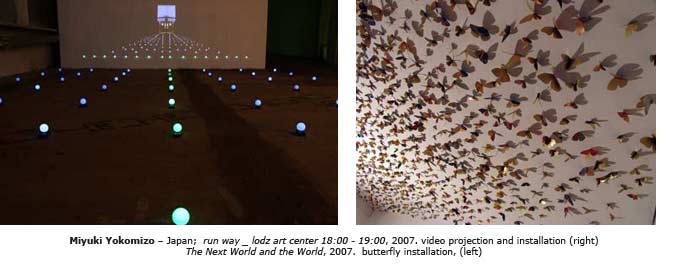
Mariusz Soltysik showed a haunting, black and white, large scale photo in a dark room, on the third floor using his own image running with w
hat appeared to be a large bear or furry creature of the night. He made another video installed at floor level, with viewing bench and blanket, titled, “interference.”
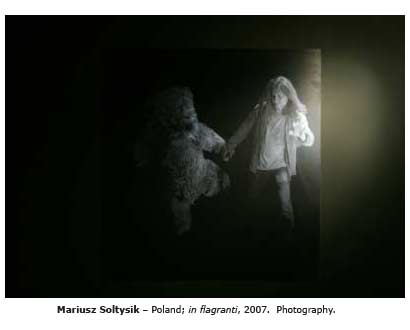
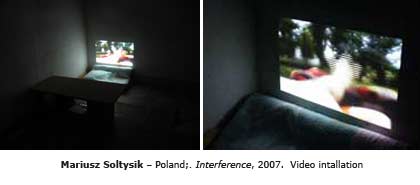
In my camouflash, I have decided to include a Polish female element. Average woman is a
mother first. It is not new; it has been like that for thousands of years.
Giving birth – the simplest, the most primitive and unquestionable way to identify own
identity. It is also a way of providing a justification for your own existence and a way to
satisfy the need to do something important which may be, at the same time, a camouflage
and a flash. Ewa Szczyrek-Potocka

Adam Klimczak who has often worked with the double image of himself, and his father, showed a video playing on a laptop computer. He had a second sound piece installed at the Gallerie Wschodnia, that he runs with Jerzy Grzegorski. After the Camouflash opening Friday night, we spent the evening at Adam’s gallery, with the same name as the street in Lodz, at 29 Wschodnia. http://www.wschodnia.pl/wschodnia_ang.html It is an extraordinary living, gallery space, with two, equally sized, connecting rooms, about 1200 sq. ft. Adam and Jerzy created the first, independent gallery in Poland, in 1981. The artist’s themselves have supported the gallery entirely from the onset, with some grants for individual projects. Adam Klimczak has been an important and dynamic force, behind much of the independent, artist organized activities in Lodz and abroad. It was clear to me that this is the place where the art spirit of Lodz is centered.
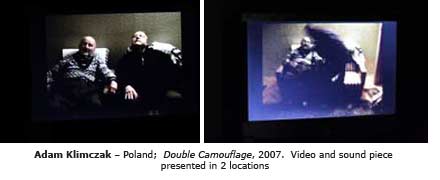 It is impossible for me to write about Camouflash, without including the historical context of the meeting of this group of artists, even though it is a small off shoot, of the global outreach of The International Artists Museum in Lodz. What is most important is the strength and undying spirit of the “IDEA.” At this moment the IAM has no physical home in Lodz, since it’s building has been taken back by the city, but has created a vital global network of artistic warriors.
It is impossible for me to write about Camouflash, without including the historical context of the meeting of this group of artists, even though it is a small off shoot, of the global outreach of The International Artists Museum in Lodz. What is most important is the strength and undying spirit of the “IDEA.” At this moment the IAM has no physical home in Lodz, since it’s building has been taken back by the city, but has created a vital global network of artistic warriors.
The Idea being, that the originating visions and actions, creating societal change, movement and flux, comes directly from the artist. So rather than the Museum Director and curators (not the ones that are also artists) herd us into the coral of the white cube, to be milked for sustenance, why not create an environment for the artists, by the artists. Skip the middle man, and create from the the source, in a most direct expression. At times the artist as organizer can be quite unorganized, but it is out of this chaos of collaboration, and open hearted sharing of time and space, that dialogue and form takes shape. The collaborative spirit is the positive energy that comes out of this kind of organization.
The globalization of The Artist Museum has taken on a life and form of it’s own, as “a worldwide channel of communication linking artists and intellectuals from variety of domains through a growing global network of autonomous, locally run art centers, interactive and independently creating an independent art-space for artists.” http://www.creatingpeace.org/
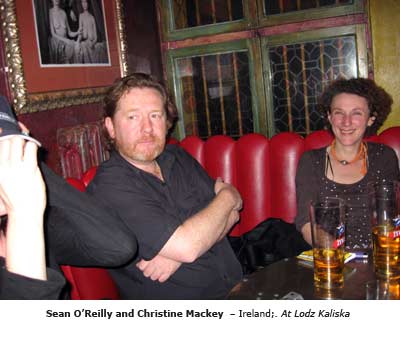 A recent and very significant undertaking to date is “Sense in Place, Site-ations International, Europe 2005/06″ which produced an enormous, hard bound catalogue, documenting the origins of the Sit-ations projects, which grew out of The Artists’ Project, IAM branch in Cardiff, Wales which hosted the first Sit-tations in 1994, directed by Sean O’Reilly with curators from both Wales and Poland. This event was my first encounter with this group of international artists. I was very happy to find out about the catalogue and receive a copy during the Camouflash event. I was also very pleased to meet up with Sean O’Reilly, who arrived the day before the opening with Christine Mackey from Ireland.
A recent and very significant undertaking to date is “Sense in Place, Site-ations International, Europe 2005/06″ which produced an enormous, hard bound catalogue, documenting the origins of the Sit-ations projects, which grew out of The Artists’ Project, IAM branch in Cardiff, Wales which hosted the first Sit-tations in 1994, directed by Sean O’Reilly with curators from both Wales and Poland. This event was my first encounter with this group of international artists. I was very happy to find out about the catalogue and receive a copy during the Camouflash event. I was also very pleased to meet up with Sean O’Reilly, who arrived the day before the opening with Christine Mackey from Ireland.

I was disapppointed not to be able to see Wasko in Lodz. I was told he is taking a step back from artist organizing, to make his own work. He was preparing for an exhibition of new paintings, which opened at Gallerie 86, in Lodz, the following Tuesday, after the Camouflash opening. Unfortunately, the U.S. contingent, left on Sunday to fly back to New York, and we were unable to attend. As Waskos’ concept of Construction in Process has been embraced around the world members have moved out in different directions. In 2004 the first Lodz Biennale took place and was described by Richard Vine in Art in America, April, 2004 like this:
“The unconventional undertaking marks the culmination of a 23-year struggle by artist-organizer Ryszard Wasko, who conceived the artist-run IAM in 1981, in the heyday of the Solidarity Freedom Movement. Inviting well-known international practitioners to Lodz under the auspices of the largely fictional Archives of Contemporary Thought (consisting of an apartment closet filled with documents, a typewriter and some letterhead stationery), he launched Construction in Process, a freewheeling residency-cum-exhibition designed to engage local workmen and the general public, that has occurred seven times at sporadic intervals in locales ranging from Munich to Melbourne to the Negev Desert.”
In 2006, another less ambitious Lodz Biennale took place, with mostly artists from Poland. It is unclear what will happen to this event, since The International Artist Museum space is gone. It may be a sign that taking on the conventional name of Biennale, was not the right direction for the founders to have taken this unconventional, independent Museum. In the mean time, “Hat’s Off” to artist organizers making there own work. It will be interesting to see how the IAM evolves from here.
We treat the participants alike: the artists, writers, poets, musicians, critics, the assistants, the support staff—they are all artists, friends. There is no difference; without them, Construction in Process would not exist. Construction in Process has always been an artistic, social and political event generated by the artists. But it is not simply idealistic, romantic. What we do is also reality; it is people working together. Another definition for Construction in Process, if you like, is just conscious activity; who, if not artists, should champion conscious activity? Ryszard Wasko
photo credits: Mariusz Sołtysik, Pawel Pilat, Erika Knerr, Mariousz “Benek” Olszewski, Suzy Sureck
Allan Kaprow 18 Happenings in six parts [re-doing]Saturday November 10th, 2007 at 4pmBrooklyn New York, Deitch StudiosPerforma 2007Jessica Higgins
photos: Geoffrey Hendricks
Red, Green, Yellow re-do PoemHannah mentioned afterwards that Allan had finally given permission to redo these happenings before passing away. Geoff Hendricks recalled the 1958 original.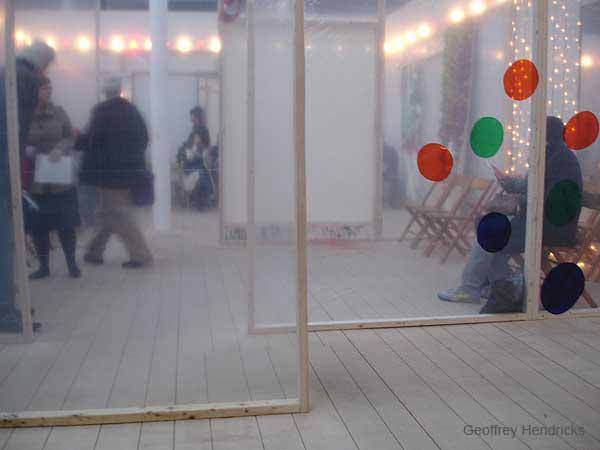 The apple panel appears as shrine, precision and messiness recalling Allan’s reproduced structure of Mondrian, master of Shapiro graduate studies…
The apple panel appears as shrine, precision and messiness recalling Allan’s reproduced structure of Mondrian, master of Shapiro graduate studies…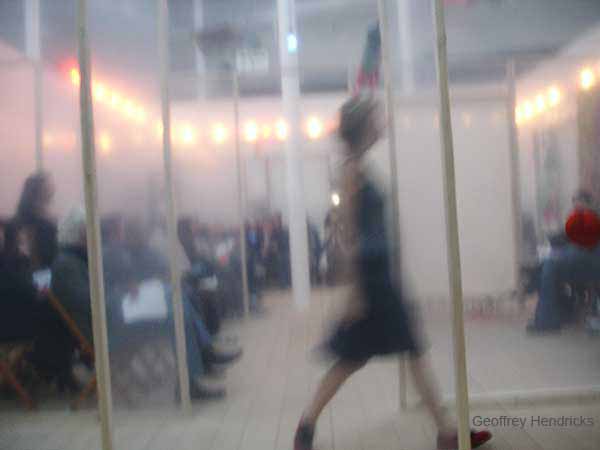 Innovation and rebellion…. StructuralObtuse voices of the 60’s
Innovation and rebellion…. StructuralObtuse voices of the 60’s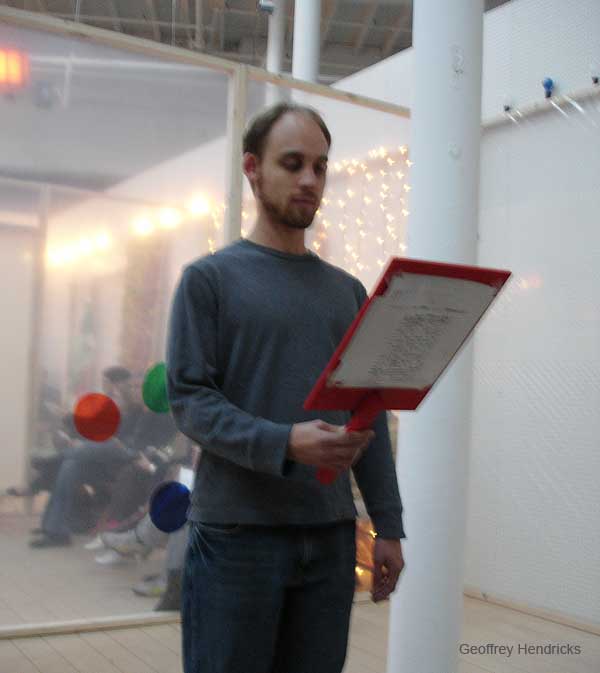 It’s never the same as I keep referring to my Red, Green, Yellow ticket hand written with directions, seeing through to the other rooms as others refer to their own tickets, familiar and unfamiliar faces. We have our directions.
It’s never the same as I keep referring to my Red, Green, Yellow ticket hand written with directions, seeing through to the other rooms as others refer to their own tickets, familiar and unfamiliar faces. We have our directions.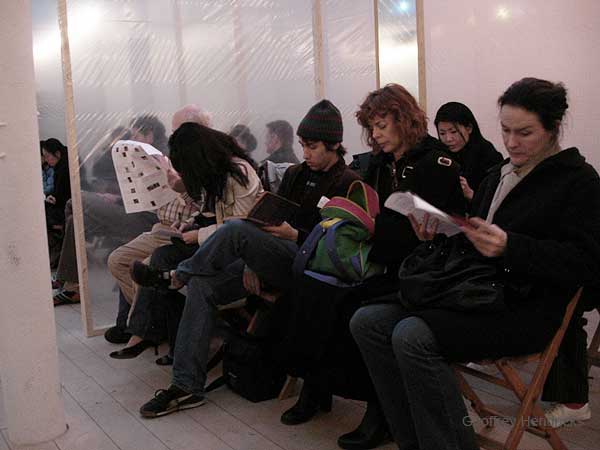 Grid like motions, music and poetry a site loosely and concisely containing translucent squares, and windows on the ceiling
Grid like motions, music and poetry a site loosely and concisely containing translucent squares, and windows on the ceiling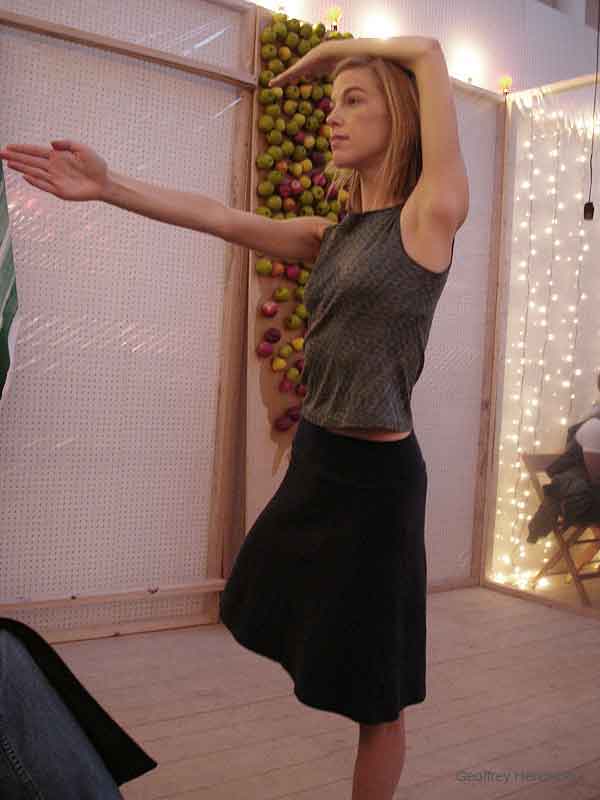 Walking squares, 3 performers read
Walking squares, 3 performers read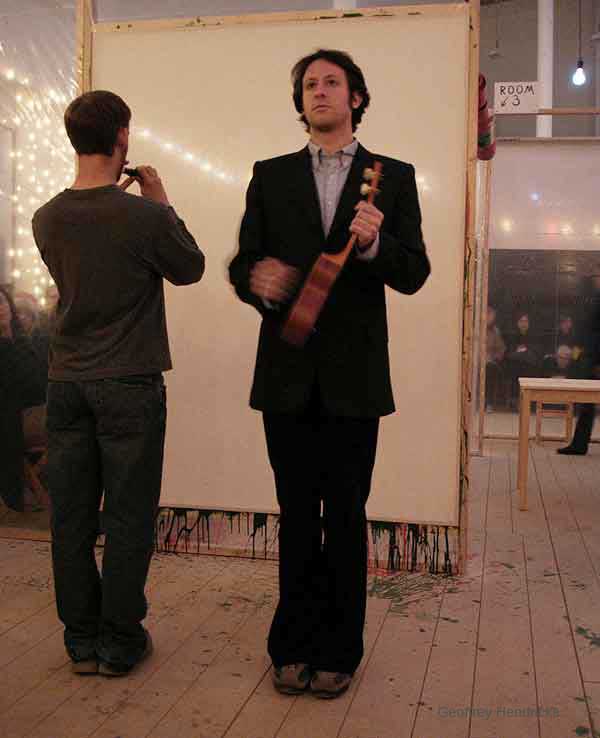 Through translucent plastic 2 red scrolls, 2 green scrolls . . . writing ‘the any for hop’ ‘just a this’
Through translucent plastic 2 red scrolls, 2 green scrolls . . . writing ‘the any for hop’ ‘just a this’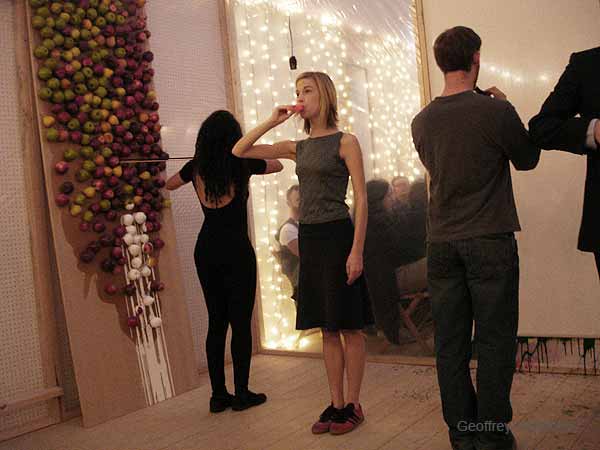 Painting on translucent canvas both sides simultaneously . . . room six Cartesian slide projections
Painting on translucent canvas both sides simultaneously . . . room six Cartesian slide projections
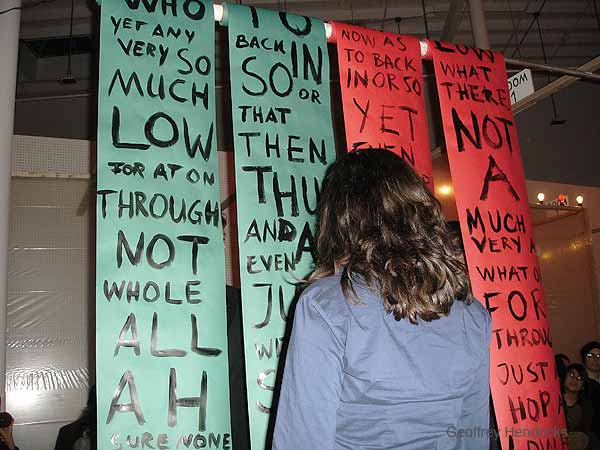
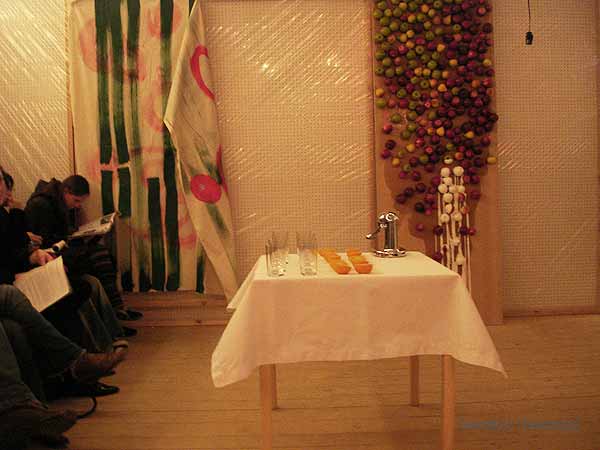
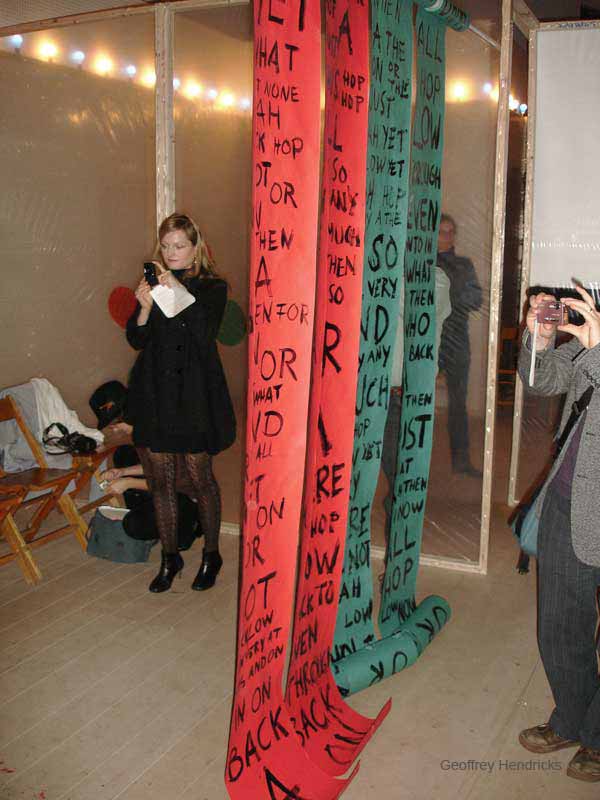
Geoff’s voice transports us as Allan is reflected back to me
Camouflash,
an international artists meeting
curators: Mariusz Sołtysik, Aurelia Mandziukcoordinators: Agata Nowicka, Małgorzata Nowak
correspondent, Erika Knerr
The exhibition is currently on view until 27 October 2007 at Patio Art Center, The Academy of Humanities and Economics, in Łódź, Poland. Below are some shots of the opening night, friday, 12 October. The evening started with a press conference at the Patio Gallery space with the artists, curators, staff, students, faculty and public.
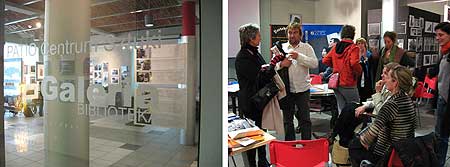 Participants and guests then moved across the courtyard to the Camouflash exhibition spaces.
Participants and guests then moved across the courtyard to the Camouflash exhibition spaces.
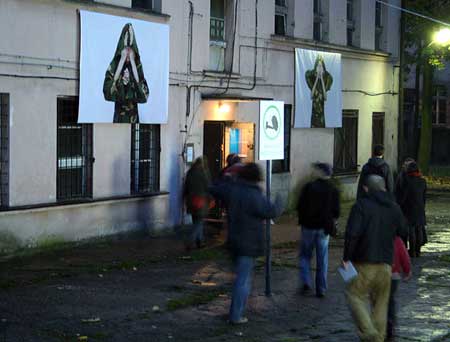
Shilpa Gupta from India showed large photographs on the outside front of the building and Kristaps Gulbris from Latvia installed a signpost titled, “No Security Cameras Here.” An intermedia peformance by Jessica Higgins took place at 6:30 pm called “Poem Song.” She was assisted by Erika Knerr with saxaphone performed by Tomasz Ogrodowczyk.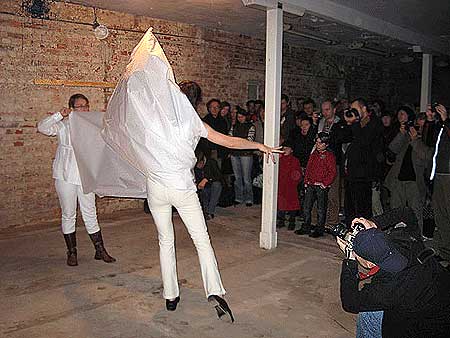
http://ww6.tvp.pl/6527,20071008575548.strona
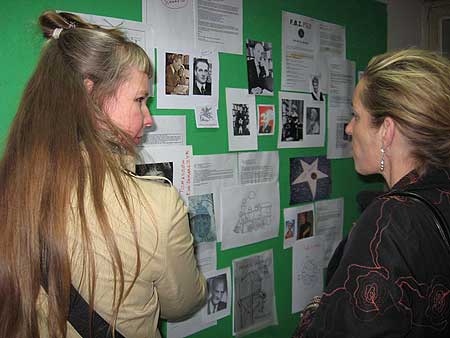 Participating artist Anna MacLeod (right) from Ireland discusses with viewer the research wall of drawings, photos and text for Olga Bergmann’s video based on the poet Julian Tuwim from Lodz and Oscar winning actress Judy Holliday (Judith Tuwim), who are both distant relatives of Bergmann from Iceland.
Participating artist Anna MacLeod (right) from Ireland discusses with viewer the research wall of drawings, photos and text for Olga Bergmann’s video based on the poet Julian Tuwim from Lodz and Oscar winning actress Judy Holliday (Judith Tuwim), who are both distant relatives of Bergmann from Iceland.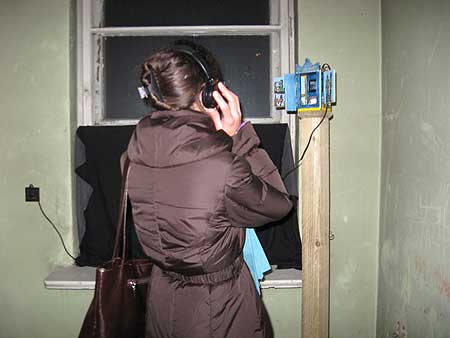
An opening goer interacting with Irish artist Christine Mackey’s intimate video “Beyond Soundings – (mobile shrine)” which is a ‘tourist’ record of an event at Wagah Post, a road crossing that divides India and Pakistan.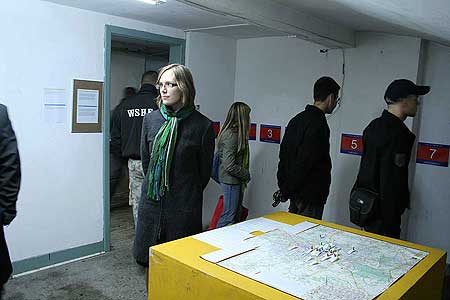
“Nicknames” by Aisling O’Beirn from Ireland.
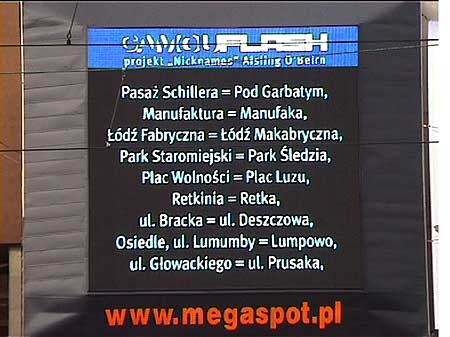
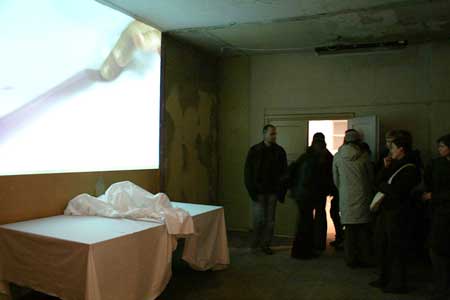 A video and table made for Camouflash event by Janusz Baldyga from Poland.
A video and table made for Camouflash event by Janusz Baldyga from Poland.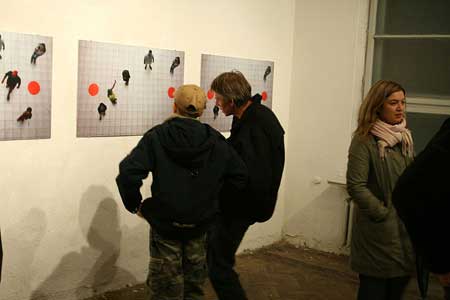 Eyeballing “Perfect Symmetry,” photographs by Tomasz Matuszak from Lodz.
Eyeballing “Perfect Symmetry,” photographs by Tomasz Matuszak from Lodz.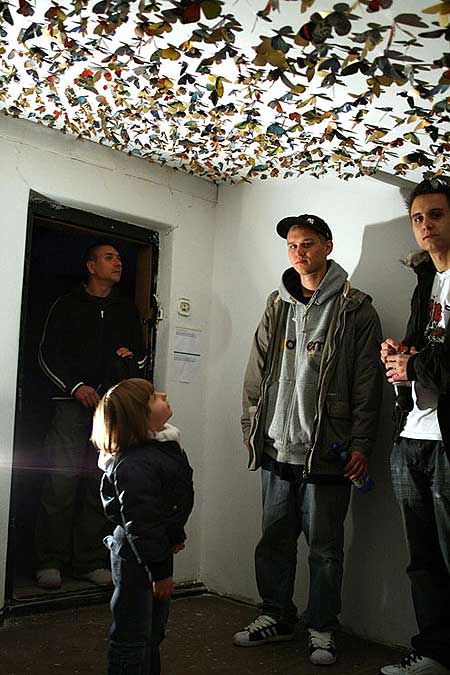
One of the younger opening attendees taking in the ceiling installation of butterflies by Miyuki Yokomizi from Japan.
photo credits: Mariusz Sołtysik, Pawel Pilat, Erika Knerr, Kristaps Gulbris
Feature articles about Camouflash will be published throughout the following weeks.
